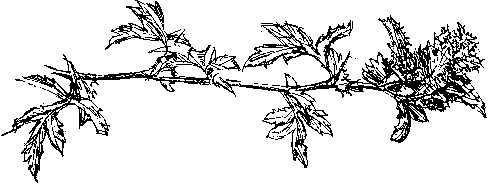 |
Hawthorn Rosette GallMonday 6th August 2001, West Yorkshire |
![]()
![]()
![]()
![]()
![]()
![]() This Month
Rocks
History
Workshop
Links
Home Page
This Month
Rocks
History
Workshop
Links
Home Page
![]()

I FOUND THIS Hawthorn Rosette Gall, which is caused by the gall-wasp Dasyneura crataegi, when I was gathering up the trimmings after cutting the garden hedge. If I'd spotted it before I snipped it off I would have been tempted to leave it there, as I have the Robin's pincushion on the wild rose at the other side of the back garden.
The gall-wasp larvae find food and shelter amongst the closely packed leaves of the rosette. In a month or so the larvae would have fallen to the ground to pupate. The rosettes often remain on hawthorns throughout the winter.
I stick it back in the hedge after making my sketch. Perhaps some of the larvae will find shelter elsewhere amongst the leaves. In The Pocket Encyclopaedia of Plant Galls Arnold Darlington observes
 that the numerous small red larvae will rapidly leave a gathered gall.
that the numerous small red larvae will rapidly leave a gathered gall.He describes the deformation and thickening of the leaves in the rosette, the reduction in the length of leaf-stalks and the greenish or reddish outgrowths scattered over the surface. The gall forms on a terminal bud but these effects can extend to adjacent leaves. Is the gall-forming effect spread by a chemical carried in the sap of the hawthorn bush? Darlington suggests an experiment to investigate the possibility.
Related Link
A list of plant galls and gall makers compiled by Willis Bramley of the Ryedale Natural History Society in North Yorkshire.![]()
Richard Bell,
wildlife illustrator
E-mail; 'richard@willowisland.co.uk'
![]() Next page
Previous page
This day last year
This month
Nature Diary
Home Page
Next page
Previous page
This day last year
This month
Nature Diary
Home Page
![]()